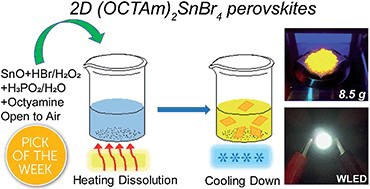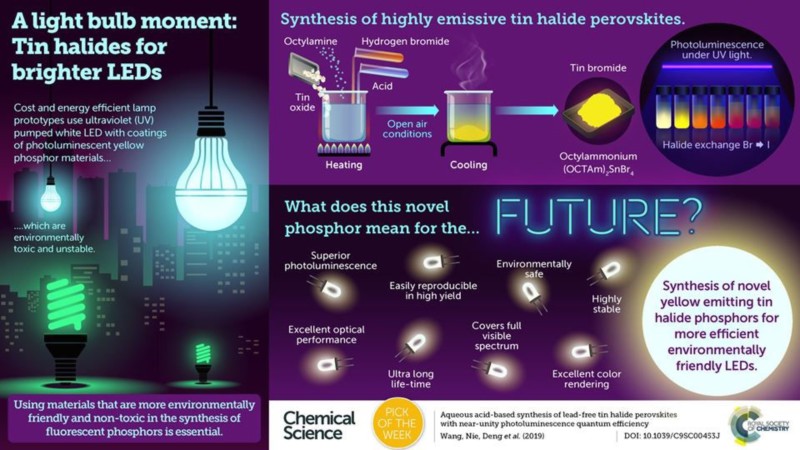自2014年以来,铅卤钙钛矿纳米晶材料因其优异的发光性能,引起了人们广泛的研究兴趣。然而,铅卤钙钛矿材料由于铅的毒性问题,对环境将产生一些潜在风险。因此,科学界一直在寻找低毒性的金属卤化物钙钛矿材料作为后备策略。锡与铅为同一主族元素,理论计算得知锡基卤化物钙钛矿材料同样具有合适的能带隙和优异的性能。锡是低毒性金属元素,正二价锡基卤化物钙钛矿材料在暴露于空气环境中,降解为正四价锡,最终变成二氧化锡,是一种环保型材料。
近年来,现代工程与应用科学学院邓正涛教授课题组在锡基钙钛矿材料的合成上获得了进展,如:2016年报道了尺寸形貌可控合成Cs2SnI6纳米晶(Chem. Mater. 2016, 28, 8132-8140)。2017年进一步可控制备了CsSnBr3 纳米笼(Chem. Mater. 2017, 29, 6493-6501)。但是,锡卤钙钛矿材料的发光缺陷较多,因为其荧光发光效率远不及同主族的铅卤钙钛矿纳米晶材料。此外,二价锡卤钙钛矿材料的稳定性很差,往往需要在惰性气体保护的手套箱中才能稳定,在空气中很快会分解。因此,获得高发光效率且性质稳定的锡卤钙钛矿材料是领域内的难题。

图1. 酸性溶液中合成2D (OCTAm)2SnX4钙钛矿发光材料和白光LED中应用。
最近,该课题组在新型锡卤钙钛矿材料研究取得了新的进展,提出了在酸性水溶液中合成高量子产率(绝对荧光量子产率接近100%)、高稳定(在室温一定湿度条件的空气下储存240天荧光无衰减)的锡基钙钛矿材料((OCTAm)2SnX4(OCTAm为辛铵阳离子,X = Br, I)),并将其作为高效的黄光荧光粉应用于白光LED中,如图 1所示。该工作于2019年3月发表在Chemical Science, 2019, Advance Article, DOI: 10.1039/C9SC00453J。该工作同时入选为“2019 Chemical Science HOT Article Collection”和“2019 ChemSci Pick of the Week Collection”。在论文在线发表当日,英国皇家化学会(RSC)网站以“A light bulb moment”为题,图文发表了相关评论文章。
现代工程与应用科学学院助理研究员王艾菲为论文第一作者,硕士生郭艳艳为第二作者,邓正涛教授和教授以及东我院学王金兰教授是论文的共同通讯作者,并得到了现代工程与应用科学学院张弢教授和聂越峰教授的帮助。以上工作得到了国家自然科学基金(Grant No. 51502130),江苏省科学自然基金项目(Grant Nos. BK20180339, BK20150581),江苏省“双创计划”, 中央高校基本科研业务费专项基金和江苏省纳米技术重点实验室的资助。
文章的链接为:
https://pubs.rsc.org/en/content/articlelanding/2019/sc/c9sc00453j#!pAbstract
RSC 网站评论文章的链接为:
https://www.rsc.org/news-events/journals-highlights/2019/mar/a-light-bulb-moment/
附RSC评论文章全文:
A light bulb moment
ChemSci Pick of the Week
Professor Zhengtao Deng and his team from Nanjing University in China have developed a new photoluminescent material that could be used to make more efficient and environmentally friendly LEDs.

Picture: © Royal Society of Chemistry/Editage
Photoluminescence is the property whereby a material absorbs light and then re-emits it over a period of time. 'Glow-in-the-dark' products are an example of photoluminescence.
"Luminous phenomena can be seen everywhere in nature, from glowing jellyfish in the ocean to fireflies in the mountain forest, from the lighting fixtures we use every day to the backlight modules in our mobile phones and laptops", says Professor Deng.
The new materials were made from tin halides, and their colour can be tuned between yellow and red by changing the halide composition. They have an efficiency of almost 100% – meaning they emit almost as much light as they absorb.
The authors believe that the tin halides could be used in LEDs in people’s daily lives within 5 to 10 years – bringing advantages such as lower energy consumption and more realistic display technologies.
This article is free to read in our open access, flagship journalChemical Science: Jinlan Wang, Shuming Nie, Zhengtao Denget al., Chem. Sci., 2019, Advance Article.DOI: 10.1039/C9SC00453J. You can access our 2019ChemSciPicks in thisarticle collection.
(现代工程与应用科学学院 科学技术处)